SAMPLE SYSTEM OPERATION/FAILURE MODE SCENARIOS FOR FAA-S-8081-4D
The G1000 system allows for realistic failures to be simulated safely and does not require a substantial change to the administration
of the practical examination. Aircraft system knowledge is still important in order to both understand the various failure modes and
take appropriate corrective action.
NOTE: Recommendations from individual aircraft manufacturers supersede any guidance provided in this document. Detailed
system data can be obtained from the aircraft Pilot Operating Handbook (POH) and/or Aircraft Flight Manual Supplement
(AFMS).
With the emphasis on Single Pilot Resource Management (SRM), Aeronautical Decision Making (ADM) and Risk Management
(RM), certain operational aspects of the G1000 system should be evaluated. These aspects are covered in FAA-S-8081-4D under the
"Special Emphasis Areas" in the categories of collision avoidance, controlled flight into terrain (CFIT), ADM and RM, and include the
following items:
• Use of and knowledge in the operation and limitations of the terrain awareness system that is part of the G1000 system.
• Use of and knowledge in the operation and limitations of TIS traffic awareness in aircraft equipped with a GTX 33 Mode-S
transponder.
• Use of weather-related systems, such as either lightning detection devices or the Garmin GDL-69/69A weather datalink receiv-
ers.
Approaches with vertical guidance (APVs) are mentioned in the section concerning the "Aircraft and Equipment Required for the
Practical Test". APVs can be ILS-like in their lateral and vertical navigation cues, yet the associated minimums are not sufficient for
these approaches to be considered precision approaches, hence their being used only for the non-precision approach requirement.
APVs require a TSO C-146 GPS/WAAS navigator, which should be available for the G1000 system sometime in 2005.
NOTE: Please refer to the Aeronautical Information Manual (AIM) for more information on the Wide Area Augmentation
System (WAAS) and APVs.
Currently, all aircraft with the G1000 integrated avionics suite are also equipped with an attitude indicator, an altimeter and an air-
speed indicator as standby or backup instruments. This is a departure from the mantra "altitude, airspeed, and needle and ball." The
main advantage to using a standby attitude indicator is the ability to control the aircraft by providing a direct indication of pitch and
bank. With no yaw indication in the event of an AHRS failure, the applicant should be evaluated on the ability to maintain positive
control, as well as on prudent aircraft maneuvering, when compensating for the lack of yaw information. Within the turbine com-
munity, it has been the practice for years to use only an attitude indicator for backup pitch and bank information without reference to
yaw. By all accounts, this practice has shown good results.
In the same section, the applicant is required to demonstrate the ability to utilize an autopilot and/or flight management system
(FMS). In the G1000 system, the FMS functions are very similar to those used in the Garmin 400/500 series units. This should help
pilots familiar with these units make the transition to the G1000 system. The FMS functionality includes the process of creating a flight
plan, direct-to navigation and selecting, loading and activating an approach procedure. Autopilot operation is dependent upon the
make and model of the autopilot installed and is only covered in this document in reference to the operational modes consistent with
those listed in "Designee Update, Special Edition on Testing in Technologically Advanced Aircraft" by the AFS-600 (the FAA Regulatory
Support Division).
Normal preflight practices still apply in the various Areas of Operation. This includes knowledge of aircraft systems, flight instru-
ments and navigation equipment as well as the instrument cockpit check. However, the PTS diverge in the Areas of Operation IV and
VII-D. The following subsections help provide guidance as to the method with which to evaluate and simulate system failures.
190-00368-02 Rev. A
Garmin G1000 Guide for Designated Pilot Examiners & Certified Flight Instructors
7

